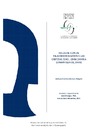Identificador persistente para citar o vincular este elemento:
https://accedacris.ulpgc.es/jspui/handle/10553/74487
| Campo DC | Valor | idioma |
|---|---|---|
| dc.contributor.advisor | Mangas Viñuela, José | - |
| dc.contributor.advisor | Menéndez González, Inmaculada | - |
| dc.contributor.author | Herrera Holguín, Adriana Catalina | - |
| dc.date.accessioned | 2020-09-18T11:41:29Z | - |
| dc.date.available | 2020-09-18T11:41:29Z | - |
| dc.date.issued | 2019 | en_US |
| dc.identifier.uri | https://accedacris.ulpgc.es/handle/10553/74487 | - |
| dc.description.abstract | Las Canteras beach outcrops correspond to vestiges of Holocene palaeoenvironments that represent changes in the sea-level and climate conditions. Under detailed stratigraphic, sedimentological, mineralogical, petrographic, geochemical and dating studies it has been possible to identify and characterise a variety of facies from Las Canteras palaeoenvironments. The basal level is a beachrock (several calcarenite layers, dipping 8 to 15 degrees seawards and with isopaque LMC cement around sand grains of marine origin) formed through a rising sea level during the Present Interglacial stage (lower Holocene >6.6 ka). Afterwards, during middle Holocene (about 6.6 ka, 14C dating), coastal progradation phase or lower sea level (or both) could lead land emersion and formation of soil, with well-developed weathering and accumulation horizons and the presence of abundant terrestrial gastropods. Overhead, but only observed in the Central Arc of the beach, eolianite facies from cemented palaeocoastal dunes were identified (calcarenite levels, dipping around 20 degrees landward, and with phreatic LMC and vadose aragonite cement) formed in the upper Holocene (<6.6 ka). This eolian deposit represents the highest coast progradation or the end of low-stand sea level, with a more recent time than the palaeosol, whereas its cementation can be interpreted as the beginning of the sea level rise towards the current highstand sea level situation. | en_US |
| dc.language | eng | en_US |
| dc.relation | Análisis de Procesos Naturales y Humanos Asociados A Los Sistemas Playa-Duna de Canarias | en_US |
| dc.relation | Diagnóstico Ambiental de Los Sistemas de Dunas de Canaris Para la Elaboración de Modelos Sostenibles | en_US |
| dc.subject | 250618 Sedimentología | en_US |
| dc.subject | 250611 Mineralogía | en_US |
| dc.subject.other | Holocene | en_US |
| dc.subject.other | Palaeoenvironmnets | en_US |
| dc.subject.other | Las Canteras beach | en_US |
| dc.title | Holocene coastal palaeoenvironments in Las Canteras beach, Gran Canaria (Canary Islands, Spain) | en_US |
| dc.title.alternative | Paleoambientes costeros del Holoceno en la playa de Las Canteras, Gran Canaria (Islas Canarias, España) | en_US |
| dc.type | info:eu-repo/semantics/masterThesis | en_US |
| dc.type | MasterThesis | en_US |
| dc.contributor.departamento | Departamento de Física | en_US |
| dc.contributor.facultad | Facultad de Ciencias del Mar | en_US |
| dc.investigacion | Ciencias | en_US |
| dc.type2 | Trabajo final de máster | en_US |
| dc.description.notas | Máster en Oceanografía ; 2018-2019 | en_US |
| dc.utils.revision | Sí | en_US |
| dc.identifier.matricula | TFT-42334 | es |
| dc.identifier.ulpgc | Sí | en_US |
| dc.contributor.buulpgc | BU-BAS | en_US |
| dc.contributor.titulacion | Máster Universitario en Oceanografía por la Universidad de Cádiz, la Universidad de Las Palmas de Gran Canaria y la Universidad de Vigo | es |
| item.fulltext | Con texto completo | - |
| item.grantfulltext | open | - |
| crisitem.advisor.dept | GIR IOCAG: Geología Aplicada y Regional | - |
| crisitem.advisor.dept | IU de Oceanografía y Cambio Global | - |
| crisitem.advisor.dept | Departamento de Física | - |
| crisitem.advisor.dept | GIR IOCAG: Geología Aplicada y Regional | - |
| crisitem.advisor.dept | IU de Oceanografía y Cambio Global | - |
| crisitem.advisor.dept | Departamento de Física | - |
| crisitem.project.principalinvestigator | Hernández Calvento, Luis Francisco | - |
| crisitem.project.principalinvestigator | Hernández Calvento, Luis Francisco | - |
| Colección: | Trabajo final de máster Restringido ULPGC | |
Visitas
164
actualizado el 10-ago-2024
Descargas
141
actualizado el 10-ago-2024
Google ScholarTM
Verifica
Comparte
Exporta metadatos
Los elementos en ULPGC accedaCRIS están protegidos por derechos de autor con todos los derechos reservados, a menos que se indique lo contrario.
